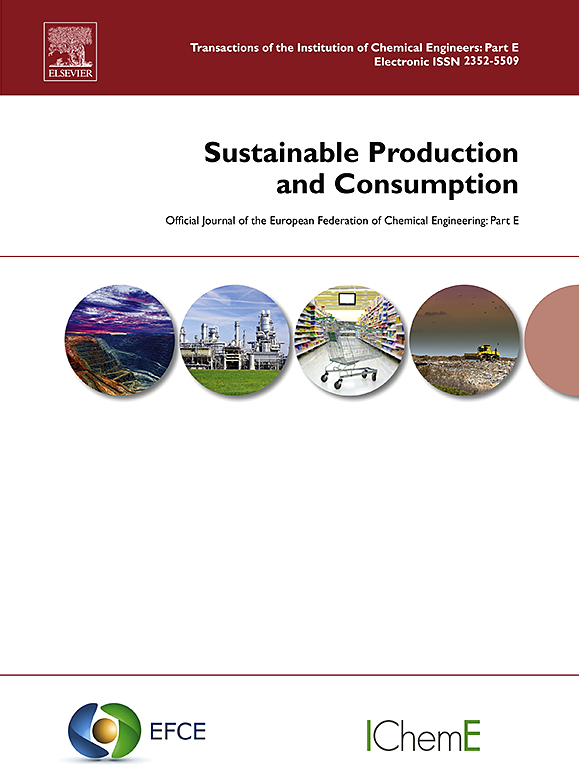Environmental life cycle assessment methods applied to amine-ionic liquid hybrid CO2 absorbents
IF 10.9
1区 环境科学与生态学
Q1 ENVIRONMENTAL STUDIES
引用次数: 0
Abstract
A hybrid solvent mixture of triethyl(octyl)phosphonium cyanopyrrolide [P2228][2-CNPyr] and aqueous monoethanolamine (MEA) has the potential for absorbing CO2 from post combustion flue gas. However, previous studies have found that the production of phosphonium based ionic liquids (IL) had significantly higher potential environmental impacts compared to MEA. Literature attributes these higher environmental impacts to the phosphine and phosgene-based intermediates required to produce the phosphonium ion of the ionic liquid.
This study proposes a novel synthesis pathway that eliminates the need for phosphine and phosgene intermediates in the production of [P2228][2-CNPyr]. The environmental impacts of producing 1 kg of the ionic liquid through this novel synthesis route was evaluated using the TRACI 2.1 methodology within the life cycle assessment (LCA) framework. Additionally, the environmental impacts for the production of 1 kg of a hybrid solvent was also evaluated and compared against MEA. The life cycle inventory for the production of the IL and its hybrid solvent were calculated based on the stoichiometry and then scaled up.
This study found that the IL and its hybrid solvents had higher environmental impacts among 9 of the 10 environmental impact categories calculated by the TRACI 2.1 methodology, except for the ecotoxicity potential. A sensitivity analysis indicated that these solvents were more sensitive to the assumptions of the material requirements of the phosphonium cation than the overall energy or transportation requirements. Despite this sensitivity, both the solvents demonstrated a lower Ecotoxicity Potential compared to MEA, the rest of the environmental impacts were still found to be higher than that of MEA, thereby underscoring the need to investigate novel synthesis routes for the production of phosphonium cation. The uncertainty analysis performed confirmed the findings that the IL has a higher environmental impact potentials across all categories except ecotoxicity potential. The uncertainty analysis also confirms that the phosphonium cation is a major hotspot in production route of these solvents and a source of uncertainty in the model compared to the anion.
Overall, this study underscores the need for investigating novel green chemistry pathway for the synthesis of phosphonium based ionic liquids, such as [P2228][2-CNPyr], to ensure that the these ILs can be a truly green alternative to MEA by not only offering superior CO₂ capture capacity compared to MEA but also being sustainably produced.
胺-离子液体混合型CO2吸收剂的环境生命周期评价方法
三乙基(辛基)磷氰吡咯烷[P2228][2-CNPyr]和水单乙醇胺(MEA)的混合溶剂混合物具有从燃烧后烟气中吸收CO2的潜力。然而,先前的研究发现,与MEA相比,磷基离子液体(IL)的生产具有明显更高的潜在环境影响。文献将这些较高的环境影响归因于生产离子液体的磷离子所需的磷化氢和基于光气的中间体。本研究提出了一种新的合成途径,在生产[P2228][2-CNPyr]时不需要磷化氢和光气中间体。在生命周期评估(LCA)框架内,使用TRACI 2.1方法评估了通过这种新合成路线生产1千克离子液体的环境影响。此外,还对生产1公斤混合溶剂的环境影响进行了评估,并与MEA进行了比较。根据化学计量学计算了IL及其杂化溶剂生产的生命周期清单,并按比例放大。本研究发现,在TRACI 2.1方法计算的10个环境影响类别中,除生态毒性潜力外,IL及其混合溶剂在9个类别中具有较高的环境影响。灵敏度分析表明,这些溶剂对磷离子的材料要求的假设比对总能量或运输要求的假设更敏感。尽管具有这种敏感性,但与MEA相比,这两种溶剂的生态毒性潜力都较低,但其余的环境影响仍高于MEA,因此强调了研究生产磷阳离子的新合成途径的必要性。进行的不确定性分析证实了IL在除生态毒性潜力外的所有类别中具有更高的环境影响潜力的发现。不确定度分析也证实了磷离子是这些溶剂生产路线的主要热点,与阴离子相比,它是模型不确定度的来源。总的来说,本研究强调需要研究新的绿色化学途径来合成磷基离子液体,如[P2228][2-CNPyr],以确保这些离子液体不仅具有比MEA更好的CO 2捕获能力,而且能够可持续生产,从而成为MEA的真正绿色替代品。
本文章由计算机程序翻译,如有差异,请以英文原文为准。
求助全文
约1分钟内获得全文
求助全文
来源期刊

Sustainable Production and Consumption
Environmental Science-Environmental Engineering
CiteScore
17.40
自引率
7.40%
发文量
389
审稿时长
13 days
期刊介绍:
Sustainable production and consumption refers to the production and utilization of goods and services in a way that benefits society, is economically viable, and has minimal environmental impact throughout its entire lifespan. Our journal is dedicated to publishing top-notch interdisciplinary research and practical studies in this emerging field. We take a distinctive approach by examining the interplay between technology, consumption patterns, and policy to identify sustainable solutions for both production and consumption systems.
 求助内容:
求助内容: 应助结果提醒方式:
应助结果提醒方式:


